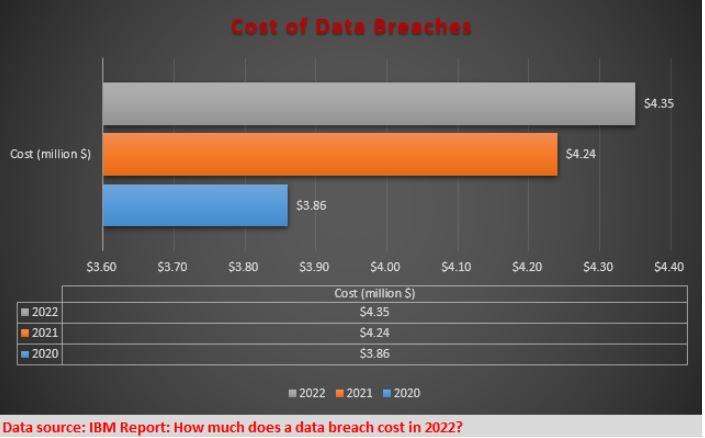The role of “intelligence” is to pre-empt potential threats to any environment – be it in economical, government, or not-for-profit settings. Cyber threat intelligence services fulfil that critical function. Their primary role is to study and document the characteristics and behavioral patterns of malicious actors, and then use that information to help cyber security professionals thwart potentially harmful actions against an environment.
Real World Cost-benefits
In 2020, IBM reported the average cost of a data breach to be $3.86-million. That estimate climbed to $4.24-million in 2021, and mid-way in 2022, it has reached $4.35 million. What’s startling is the fact that, over a period of just 2-years (2020-2022), the average cost of such breaches climbed by nearly 13% (12.7%). But there is a silver lining buried in the data: The pace of data breach costs (thus far, between 2021 and 2022) has declined to 2.59% – compared to the 2020-2021 (9.84%) time period.

The prevalent use of threat intelligence tools is likely one reason for that slow-down, with 42% of organizations now reporting the use of technologies to combat the threat (compared to only 35% in 2021). So, where’s the evidence that using technology to deal with cyber breaches works? IBM found that organizations using such tools, on the average, spent $1-million less on data breaches compared to those that didn’t use such technologies. Clearly, the benefits of deploying cybersecurity technologies far outweigh the costs!
Working as a Team
Whether it’s a local area network (LAN), a wide-area network (WAN), or cloud-based deployments, threat intelligence services can’t function in isolation. It takes a partnership of both internal and external resources – tools, technologies, and personnel – to effectively combat potential cyberthreats. Unfortunately, given how traditional technologies function – as data silos, and within specific domains, there’s often a significant lag between understanding potential threats, and combating them.
Most cyber criminals rely on this “disconnect” between various cybersecurity partners. Because of this lack of cohesiveness, most organizations fall short in their security orchestration, automation, and response (SOAR) capabilities. There is a need for rapid threat detection and highly effective incident response. Without such an integrated threat response in place, the reaction to cyber incidents is akin to the proverbial “bolting the barn doors after the horses have bolted!”.
Proof of Effectiveness
And that’s where the QuoLab platform excels!
Using a well-developed data graphing model, highly integrated link analysis protocols, proprietary parsing technology, and a host of other threat intelligence tools, the Platform has proved itself a highly effective weapon in the arsenal of cybersecurity professionals. With data and malware processing times slashed by over 50%, and a more than 480% increase in threat matching speeds, this is a more sophisticated threat intelligence platform (TIP) than most commercial threat intelligence services have to offer.
In times of crisis, security operations center (SOC) teams require undivided focus on response to the threat, and un-impinged ability on recovery efforts. By facilitating collaborative efforts, between in-house teams and external support providers, the QuoLab platform shortens the time between identifying potential threats, and mounting a robust response to it.













